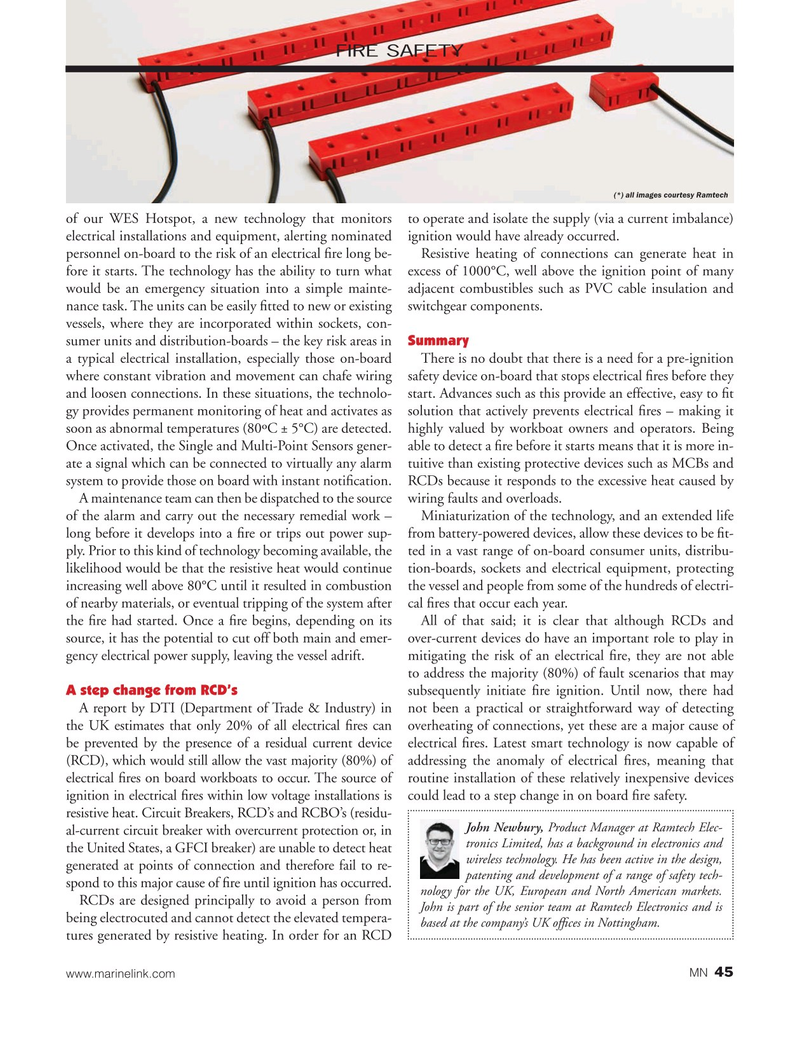
Page 45: of Marine News Magazine (July 2019)
Propulsion Technology
Read this page in Pdf, Flash or Html5 edition of July 2019 Marine News Magazine
FIRE SAFETY (*) all images courtesy Ramtech of our WES Hotspot, a new technology that monitors to operate and isolate the supply (via a current imbalance) electrical installations and equipment, alerting nominated ignition would have already occurred.
personnel on-board to the risk of an electrical ? re long be- Resistive heating of connections can generate heat in fore it starts. The technology has the ability to turn what excess of 1000°C, well above the ignition point of many would be an emergency situation into a simple mainte- adjacent combustibles such as PVC cable insulation and nance task. The units can be easily ? tted to new or existing switchgear components. vessels, where they are incorporated within sockets, con- sumer units and distribution-boards – the key risk areas in Summary a typical electrical installation, especially those on-board There is no doubt that there is a need for a pre-ignition where constant vibration and movement can chafe wiring safety device on-board that stops electrical ? res before they and loosen connections. In these situations, the technolo- start. Advances such as this provide an effective, easy to ? t gy provides permanent monitoring of heat and activates as solution that actively prevents electrical ? res – making it soon as abnormal temperatures (80ºC ± 5°C) are detected. highly valued by workboat owners and operators. Being
Once activated, the Single and Multi-Point Sensors gener- able to detect a ? re before it starts means that it is more in- ate a signal which can be connected to virtually any alarm tuitive than existing protective devices such as MCBs and system to provide those on board with instant noti? cation. RCDs because it responds to the excessive heat caused by
A maintenance team can then be dispatched to the source wiring faults and overloads. of the alarm and carry out the necessary remedial work – Miniaturization of the technology, and an extended life long before it develops into a ? re or trips out power sup- from battery-powered devices, allow these devices to be ? t- ply. Prior to this kind of technology becoming available, the ted in a vast range of on-board consumer units, distribu- likelihood would be that the resistive heat would continue tion-boards, sockets and electrical equipment, protecting increasing well above 80°C until it resulted in combustion the vessel and people from some of the hundreds of electri- of nearby materials, or eventual tripping of the system after cal ? res that occur each year. the ? re had started. Once a ? re begins, depending on its All of that said; it is clear that although RCDs and source, it has the potential to cut off both main and emer- over-current devices do have an important role to play in gency electrical power supply, leaving the vessel adrift. mitigating the risk of an electrical ? re, they are not able to address the majority (80%) of fault scenarios that may
A step change from RCD’s subsequently initiate ? re ignition. Until now, there had
A report by DTI (Department of Trade & Industry) in not been a practical or straightforward way of detecting the UK estimates that only 20% of all electrical ? res can overheating of connections, yet these are a major cause of be prevented by the presence of a residual current device electrical ? res. Latest smart technology is now capable of (RCD), which would still allow the vast majority (80%) of addressing the anomaly of electrical ? res, meaning that electrical ? res on board workboats to occur. The source of routine installation of these relatively inexpensive devices ignition in electrical ? res within low voltage installations is could lead to a step change in on board ? re safety. resistive heat. Circuit Breakers, RCD’s and RCBO’s (residu-
John Newbury, Product Manager at Ramtech Elec- al-current circuit breaker with overcurrent protection or, in tronics Limited, has a background in electronics and the United States, a GFCI breaker) are unable to detect heat wireless technology. He has been active in the design, generated at points of connection and therefore fail to re- patenting and development of a range of safety tech- spond to this major cause of ? re until ignition has occurred. nology for the UK, European and North American markets.
RCDs are designed principally to avoid a person from
John is part of the senior team at Ramtech Electronics and is being electrocuted and cannot detect the elevated tempera- based at the company’s UK of? ces in Nottingham.
tures generated by resistive heating. In order for an RCD 45 www.marinelink.com MN
MN July19 Layout 32-49.indd 45 6/20/2019 9:57:57 AM

 44
44

 46
46
